Page 164 of 595
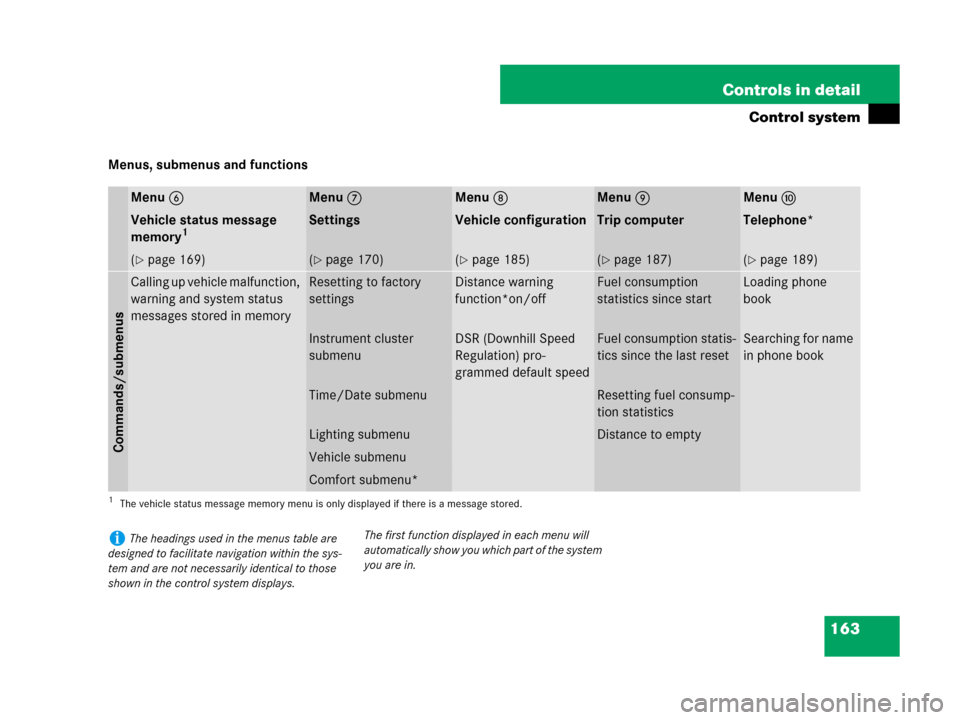
163 Controls in detail
Control system
Menus, submenus and functions
Menu6Menu7Menu8Menu9Menua
Vehicle status message
memory1
1The vehicle status message memory menu is only displayed if there is a message stored.
SettingsVehicle configurationTrip computerTelephone*
(�page 169)(�page 170)(�page 185)(�page 187)(�page 189)
Commands/submenus
Calling up vehicle malfunction,
warning and system status
messages stored in memoryResetting to factory
settingsDistance warning
function*on/offFuel consumption
statistics since startLoading phone
book
Instrument cluster
submenuDSR (Downhill Speed
Regulation) pro-
grammed default speedFuel consumption statis-
tics since the last resetSearching for name
in phone book
Time/Date submenuResetting fuel consump-
tion statistics
Lighting submenuDistance to empty
Vehicle submenu
Comfort submenu*
iThe headings used in the menus table are
designed to facilitate navigation within the sys-
tem and are not necessarily identical to those
shown in the control system displays.The first function displayed in each menu will
automatically show you which part of the system
you are in.
Page 165 of 595

164 Controls in detail
Control system
Standard display menu
In the standard display, the main odometer
and the trip odometer appear in the multi-
function display.
1Trip odometer
2Main odometer
�If you see another display, press
buttonè orÿ repeatedly until
the standard display appears.
�Press buttonk orj to select
the functions in the standard display
menu.The following functions are available:Checking coolant temperature
FunctionPage
Checking tire inflation pressure396
Checking coolant temperature164
Calling up digital speedometer
or outside temperature165
Calling up maintenance service
indicator424
Warning!G
�Driving when your engine is overheated
can cause some fluids which may have
leaked into the engine compartment to
catch fire. You could be seriously
burned.
�Steam from an overheated engine can
cause serious burns which can occur
just by opening the hood. Stay away
from the engine if you see or hear steam
coming from it.
Stop the vehicle in a safe location away from
other traffic. Turn off the engine, get out of
the vehicle and do not stand near the vehicle
until the engine has cooled down.
Page 173 of 595
172 Controls in detail
Control system
Submenus in the Settings menu
�Press buttonj.
The collection of the submenus
appears in the multifunction display.
�Press buttonç.
The selection marker moves to the next
submenu.
The submenus are arranged by hierarchy.
Scroll down with buttonç, scroll up
with the buttonæ.With the selection marker on the desired
submenu, use the jbutton to access
the individual functions within that sub-
menu. Once within that submenu, you can
use thej button to move to the next
function or thek button to move to the
previous function within that submenu.
The settings themselves are made with
buttonæ orç.
Page 187 of 595
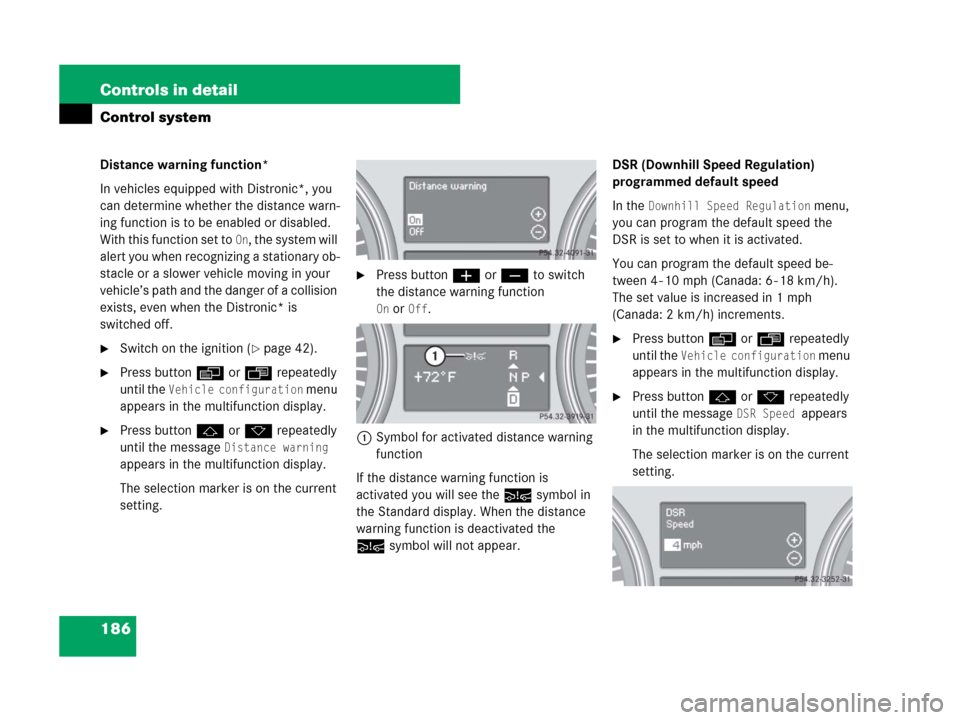
186 Controls in detail
Control system
Distance warning function*
In vehicles equipped with Distronic*, you
can determine whether the distance warn-
ing function is to be enabled or disabled.
With this function set to
On, the system will
alert you when recognizing a stationary ob-
stacle or a slower vehicle moving in your
vehicle’s path and the danger of a collision
exists, even when the Distronic* is
switched off.
�Switch on the ignition (�page 42).
�Press buttonè orÿ repeatedly
until the
Vehicle configuration menu
appears in the multifunction display.
�Press buttonj ork repeatedly
until the message
Distance warning
appears in the multifunction display.
The selection marker is on the current
setting.
�Press buttonæ orç to switch
the distance warning function
OnorOff.
1Symbol for activated distance warning
function
If the distance warning function is
activated you will see the :symbol in
the Standard display. When the distance
warning function is deactivated the
:symbol will not appear.DSR (Downhill Speed Regulation)
programmed default speed
In the
Downhill Speed Regulation menu,
you can program the default speed the
DSR is set to when it is activated.
You can program the default speed be-
tween 4 - 10 mph (Canada: 6 - 18 km/h).
The set value is increased in 1 mph
(Canada: 2 km/h) increments.
�Press buttonè orÿ repeatedly
until the
Vehicle configuration menu
appears in the multifunction display.
�Press buttonj ork repeatedly
until the message
DSR Speed appears
in the multifunction display.
The selection marker is on the current
setting.
Page 193 of 595
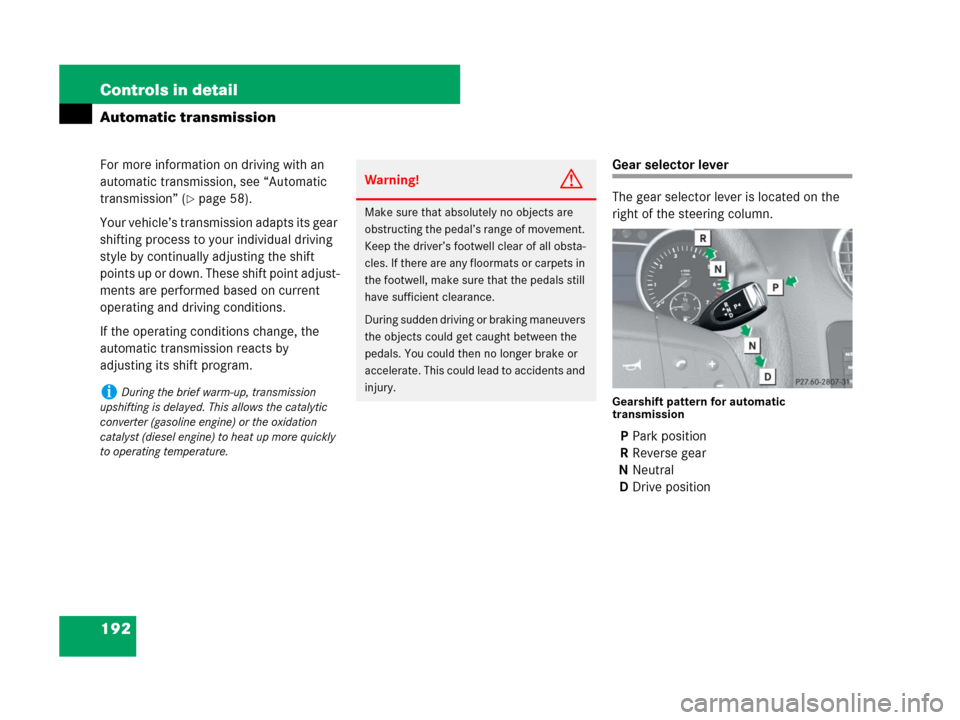
192 Controls in detail
Automatic transmission
For more information on driving with an
automatic transmission, see “Automatic
transmission” (
�page 58).
Your vehicle’s transmission adapts its gear
shifting process to your individual driving
style by continually adjusting the shift
points up or down. These shift point adjust-
ments are performed based on current
operating and driving conditions.
If the operating conditions change, the
automatic transmission reacts by
adjusting its shift program.
Gear selector lever
The gear selector lever is located on the
right of the steering column.
Gearshift pattern for automatic
transmission
PPark position
RReverse gear
NNeutral
DDrive position
iDuring the brief warm-up, transmission
upshifting is delayed. This allows the catalytic
converter (gasoline engine) or the oxidation
catalyst (diesel engine) to heat up more quickly
to operating temperature.
Warning!G
Make sure that absolutely no objects are
obstructing the pedal’s range of movement.
Keep the driver’s footwell clear of all obsta-
cles. If there are any floormats or carpets in
the footwell, make sure that the pedals still
have sufficient clearance.
During sudden driving or braking maneuvers
the objects could get caught between the
pedals. You could then no longer brake or
accelerate. This could lead to accidents and
injury.
Page 194 of 595
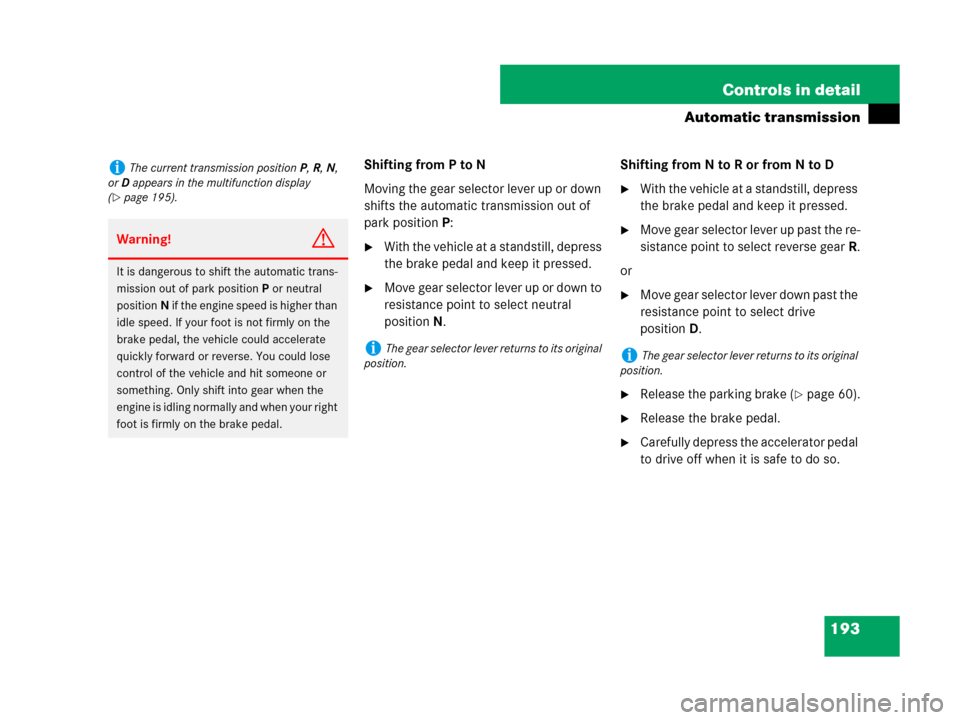
193 Controls in detail
Automatic transmission
Shifting from P to N
Moving the gear selector lever up or down
shifts the automatic transmission out of
park positionP:
�With the vehicle at a standstill, depress
the brake pedal and keep it pressed.
�Move gear selector lever up or down to
resistance point to select neutral
positionN.Shifting from N to R or from N to D
�With the vehicle at a standstill, depress
the brake pedal and keep it pressed.
�Move gear selector lever up past the re-
sistance point to select reverse gearR.
or
�Move gear selector lever down past the
resistance point to select drive
positionD.
�Release the parking brake (�page 60).
�Release the brake pedal.
�Carefully depress the accelerator pedal
to drive off when it is safe to do so.
iThe current transmission positionP, R, N,
orD appears in the multifunction display
(
�page 195).
Warning!G
It is dangerous to shift the automatic trans-
mission out of park positionP or neutral
positionN if the engine speed is higher than
idle speed. If your foot is not firmly on the
brake pedal, the vehicle could accelerate
quickly forward or reverse. You could lose
control of the vehicle and hit someone or
something. Only shift into gear when the
engine is idling normally and when your right
foot is firmly on the brake pedal.
iThe gear selector lever returns to its original
position.iThe gear selector lever returns to its original
position.
Page 195 of 595

194 Controls in detail
Automatic transmission
Shifting from P to R
�With the vehicle at a standstill, depress
the brake pedal and keep it pressed.
�Move gear selector lever up past the re-
sistance point to select reverse gearR.
�Release the parking brake (�page 60).
�Release the brake pedal.
�Carefully depress the accelerator pedal
to drive off when it is safe to do so.Shifting from P to D
�With the vehicle at a standstill, depress
the brake pedal and keep it pressed.
�Move gear selector lever down past the
resistance point to select drive
positionD.
�Release the parking brake (�page 60).
�Release the brake pedal.
�Carefully depress the accelerator pedal
to drive off when it is safe to do so.Shifting from D, R, or N to P
If you want to select park positionP with
the transmission being in drive positionD,
reverse positionR or neutral positionN:
�With the vehicle at a standstill, depress
the brake pedal and keep it pressed.
�Step firmly on parking brake pedal
(
�page 68).
�Press button on gear selector lever in
direction of arrow (
�page 192) to
select park positionP.
�Release the brake pedal.
iThe gear selector lever returns to its original
position.
iThe gear selector lever returns to its original
position.
!Shift the automatic transmission directly
from drive positionD to reverse gearR, from
reverse gearR to drive positionD or directly to
park positionP only when the vehicle is stopped.
Otherwise the automatic transmission could be
damaged.
When trying to free a vehicle stuck in mud or
snow, see “Rocking the vehicle” (
�page 199).
Page 196 of 595
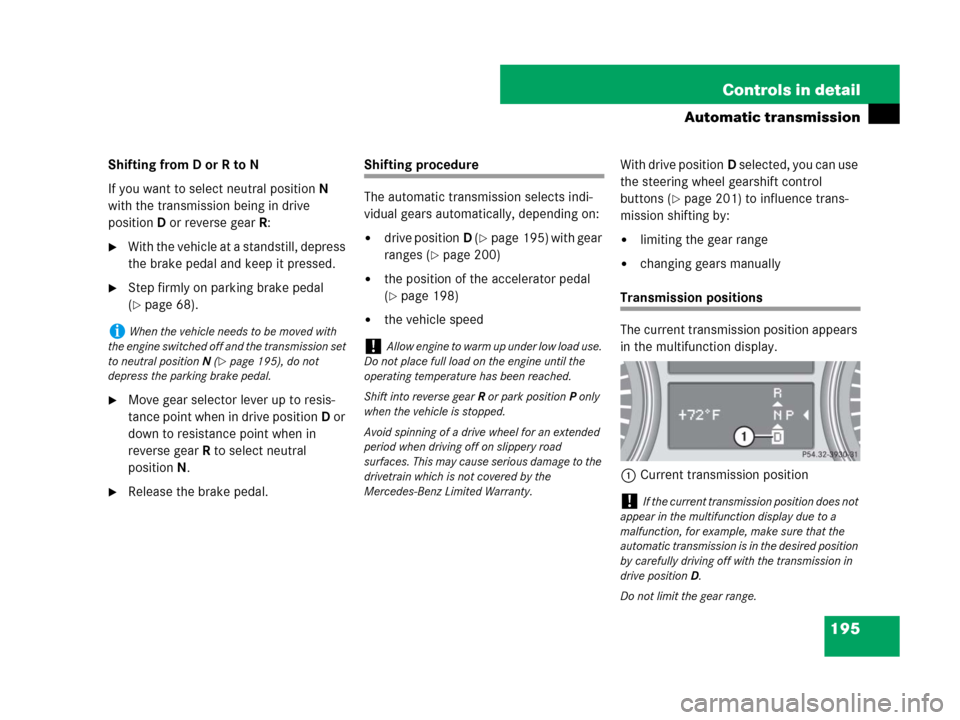
195 Controls in detail
Automatic transmission
Shifting from D or R to N
If you want to select neutral positionN
with the transmission being in drive
positionD or reverse gearR:
�With the vehicle at a standstill, depress
the brake pedal and keep it pressed.
�Step firmly on parking brake pedal
(
�page 68).
�Move gear selector lever up to resis-
tance point when in drive positionD or
down to resistance point when in
reverse gearR to select neutral
positionN.
�Release the brake pedal.
Shifting procedure
The automatic transmission selects indi-
vidual gears automatically, depending on:
�drive positionD (�page 195) with gear
ranges (
�page 200)
�the position of the accelerator pedal
(
�page 198)
�the vehicle speedWith drive positionD selected, you can use
the steering wheel gearshift control
buttons (
�page 201) to influence trans-
mission shifting by:
�limiting the gear range
�changing gears manually
Transmission positions
The current transmission position appears
in the multifunction display.
1Current transmission position
iWhen the vehicle needs to be moved with
the engine switched off and the transmission set
to neutral positionN (
�page 195), do not
depress the parking brake pedal.!Allow engine to warm up under low load use.
Do not place full load on the engine until the
operating temperature has been reached.
Shift into reverse gearR or park positionP only
when the vehicle is stopped.
Avoid spinning of a drive wheel for an extended
period when driving off on slippery road
surfaces. This may cause serious damage to the
drivetrain which is not covered by the
Mercedes-Benz Limited Warranty.
!If the current transmission position does not
appear in the multifunction display due to a
malfunction, for example, make sure that the
automatic transmission is in the desired position
by carefully driving off with the transmission in
drive positionD.
Do not limit the gear range.